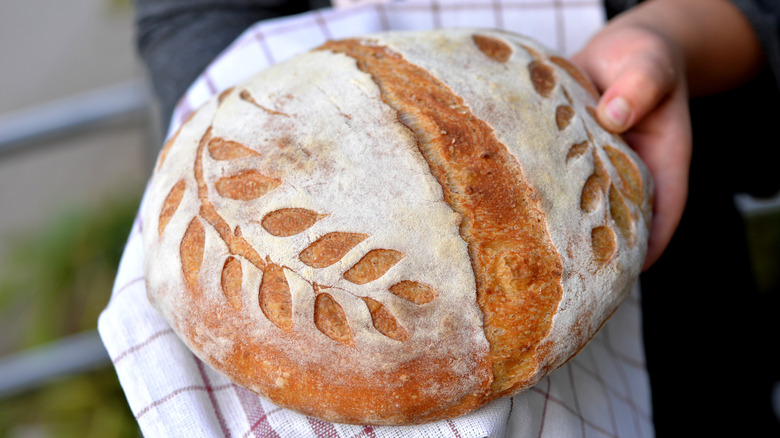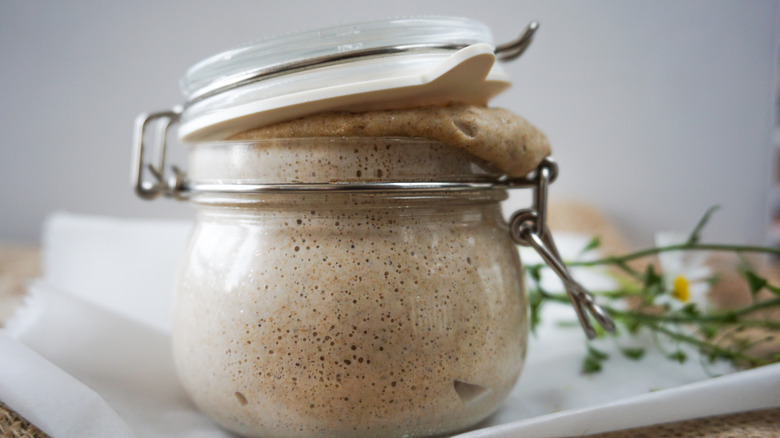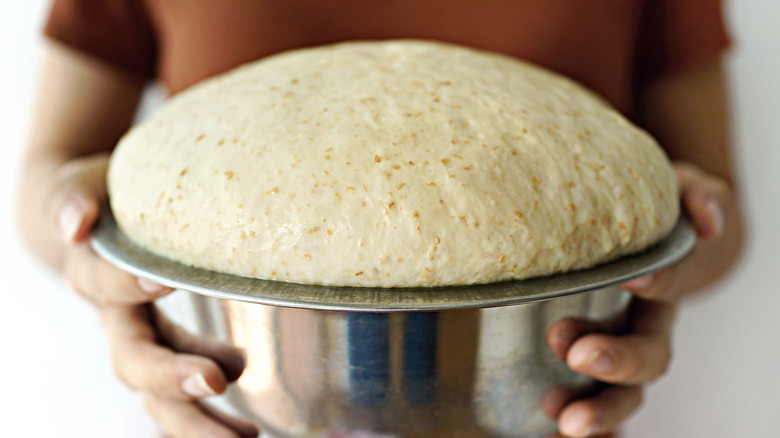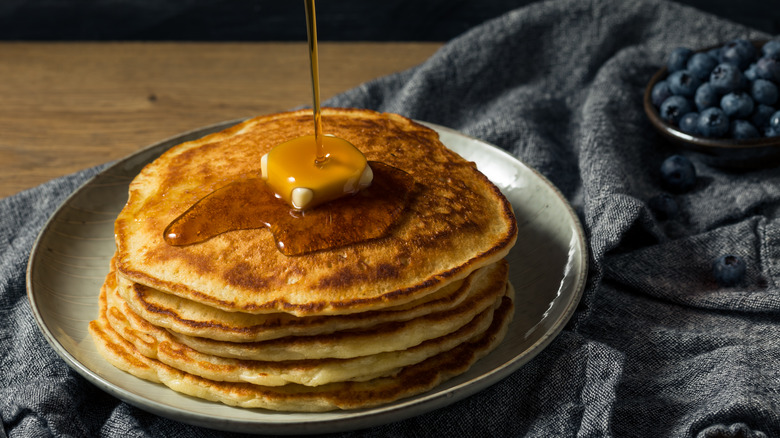The Real Reason You Should Be Baking Sourdough In The Summer
How's that sourdough starter doing? You know, that jar of goop that's been sitting in the back of the fridge somewhat neglected since the start of the summer? We get it: Feeding your starter and baking regularly was a lot easier during the sourdough bread craze, when the pandemic forced us all to spend months and months at home. Now with more people vaccinated, and more businesses and destinations reopening, it's understandable if sourdough baking has taken a back seat to camping trips, beach days, reunions, and get-togethers.
However, if you're back from vacation and your sourdough starter has survived, King Arthur Baking Company says you should really do some sourdough baking. In a recent newsletter received by Mashed, the baking company wrote, "Remember a year ago when many of us were devotedly nurturing a sourdough starter? Does that feel like a lifetime ago? Or are you still at it, feeding your starter regularly and churning out your best baking yet? Whichever camp you're in, would you consider joining me in a little sourdough baking this week?" Though the hot, humid days of late summer leave us feeling less than motivated, King Arthur Baking says it's actually a perfect time to wake up that sourdough starter and get kneading. "Sourdough thrives in this environment," they write. Here's why you should do some sourdough baking.
Hot and humid is what sourdough loves
Perhaps it's been a while since you've thought about your sourdough starter, so here's a refresher: That starter is a kind of homegrown yeast that you feed with flour and water, and maintain by removing some to let the rest grow all over again (via The Kitchn.) Sourdough starter makes your sourdough bread rise, gives it a beautiful, chewy texture with lots of lovely holes, and a distinct flavor thanks to the yeast organisms unique to your area.
If you first created your sourdough starter during the winter, it probably took a while for it to develop and grow, and a long time for your bread dough to rise. That's because temperature and humidity are pretty important to sourdough bread. According to The Chopping Block, the yeast organisms in your starter prefer warmer air, around 70 degrees or above. While that might be hard to achieve in a chilly house in the winter, during the dog days of late summer, it's plenty hot enough to get your starter bubbling and to make your dough rise fast. The higher humidity of summertime will also help your starter ferment and grow more quickly (via The Bread Guide.) It'll be so exciting to watch your starter quickly come back to life, and your bread dough rapidly expand! Just don't let the growth get out of control — you should know what to watch for.
Tips for sourdough in the summertime
Your sourdough starter and bread dough will grow faster during the summer, so you'll need to treat them a little differently than you do during winter. Letting the starter over-ferment or the dough over-proof will create off flavors and flat loaves. Say Little Hen says that because starter will exhaust its food supply more rapidly in warm weather, keep it happy by giving it smaller, more frequent feedings. Warm weather will make sourdough batter rise more rapidly, so it won't need the same length of rising time you would give it in cooler months. The Perfect Loaf recommends checking the dough often as it rises and giving it the "poke test": When you poke it with your finger the indentation should remain. The Perfect Loaf says it's better to bake your sourdough bread a little too soon rather than a little too late.
You can help slow down how rapidly your dough rises with tricks to keep it cool. The Bread Guide says to use ice water in your recipe, a fan to cool down the air, or chill the bowl and utensils before using them. King Arthur Baking also notes that when it's really humid, you can reduce the amount of water in your recipe by about 10%, so your dough won't be too wet.
Make more than just sourdough bread
As you wake up your starter for some summertime sourdough baking, remember that you can use that starter for different kinds of breads, even sweetbreads. Try using some to make a batch of homemade English muffins, which are one of those foods that taste so much better when you make them yourself. Sourdough starter also makes a tasty batch of cinnamon rolls, by using it in place of dry, instant yeast in the recipe.
And sourdough baking doesn't just refer to loaves of bread! Part of sourdough starter maintenance is to remove, or discard a portion so that the rest can continue to grow. That "discard" doesn't have to go in the trash: Keep an assortment of recipes on hand to use your sourdough discard, so you'll be motivated to feed and maintain it regularly. There are plenty of recipes that you can throw together quickly to make for your family or to bring to a potluck. King Arthur Baking has some that you've probably heard of like Sourdough Pancakes, and unique ideas like Sourdough Zucchini Bread, Sourdough Popovers, or a rich Sourdough Chocolate Cake. And the next time you're craving something savory and fried, The Gingered Whisk has a recipe for Sourdough Fried Chicken. It's not too late to have a sourdough summer!



